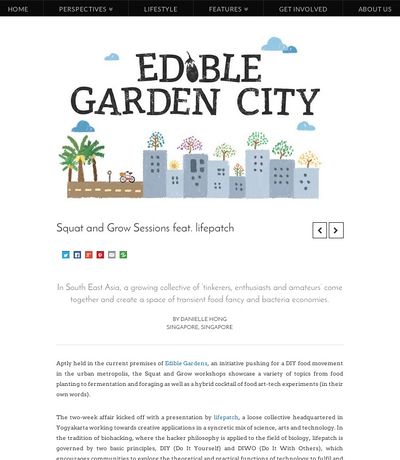Squat and Grow Sessions feat. lifepatch
Sebuah artikel oleh Danielle Hong yang dimuat di situs Entiled Mag. Artikel ini berkenaan dengan aktivitias Squat & Grow yang berlangsung pada bulan Februari di Singapura. Artikel ini disadur oleh Andreas Siagian pada tanggal 7 Maret 2015. Isi artikel dapat ditemukan di pranala luar.
Isi Artikel
In South East Asia, a growing collective of ‘tinkerers, enthusiasts and amateurs’ come together and create a space of transient food fancy and bacteria economies.
BY DANIELLE HONG, SINGAPORE, SINGAPORE.
Aptly held in the current premises of Edible Gardens, an initiative pushing for a DIY food movement in the urban metropolis, the Squat and Grow workshops showcase a variety of topics from food planting to fermentation and foraging as well as a hybrid cocktail of food art-tech experiments (in their own words).
The two-week affair kicked off with a presentation by lifepatch, a loose collective headquartered in Yogyakarta working towards creative applications in a syncretic mix of science, arts and technology. In the tradition of biohacking, where the hacker philosophy is applied to the field of biology, lifepatch is governed by two basic principles, DIY (Do It Yourself) and DIWO (Do It With Others), which encourages communities to explore the theoretical and practical functions of technology to fulfil and better collective needs.
Co-founders Agus (Timbil) Tri Budiarto and Adhari (Adee) Donora shared snippets of the numerous projects the collective has collaborated in since its inception in 2012, including the Jogja River Project (JRP), an exploratory mapping expedition to discover the watersheds around the rivers of the city. Besides producing a visual documentation and an inventory of the wildlife/vegetation of these watersheds, activities such as e-coli sampling and clean-ups were also part of the agenda, which continues today into its fifth year.
Adhering to the DIWO principle, the loose band of nine biohackers (at least for now) at lifepatch team up in each other’s projects, some more avant-garde than others. “Moist Sense”, for example, is an art-science installation that applies electronics to monitor the health of plants, using motion sensors (lights and sounds) to create an easy irrigation system. Then there are projects using fermentation and distillation to create DIY alcohol or new edibles to those mapping out street art and creating biosynthesizers from fruits and vegetables.
Over a break, Timbil shares an idea brewing in the burner for the group – the rise of local produce sold at DIY markets around Yogyakarta is commendable, but he wonders why sellers aren’t connecting as a community, or sharing much of their resources. “We want to track when these markets come, what kind of coordination or resources they can get from each other, who they are and why they do what they do.”
When asked if the numerous personal projects of the lifepatch biohackers makes it difficult to harmonise efforts or maintain some form of consistency for archival sake, Timbil gives me a smile in disbelief. “Yes, but the inconsistency is the consistency, that’s what makes it work!”
Editor’s Note: The Squat and Grow workshops ran till February, 2015 at Edible Gardens. Check out Edible Garden’s Facebook page and lifepatch’s website for more rice wine making, DIY lubrication, traditional homeopathy cures, rooftop farming, foraging trips into the forest and molecular kitchen tastings.
